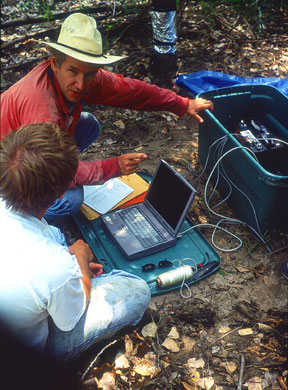| Kansas Geological Survey | Spring
2003 |
Vol.
9.2 |
|
Water Research Targets Trees
CONTENTS Water Research–page 1
|
As
ground-water levels in western Kansas continue to decline, ground-water
managers need better information about how aquifers work. At a study site
along the Arkansas River east of Larned, researchers at the Kansas Geological
Survey are looking to trees to help get a more accurate picture of how
water moves through the aquifer and connected streams. Along with others from the University of Kansas and Kansas State University,
KGS researchers are monitoring various components of the stream-aquifer
system. They want to figure out the overall water budget—that is,
how much water is coming in and flowing out of the system. Anecdotal evidence suggests that trees growing along stream channels
take large amounts of water from alluvial aquifer—those aquifers
connected to streams. However, little research has been conducted in Kansas
to quantify the impact of water use by trees on the water budget in stream-aquifer
systems. In 2002, researchers at the Larned site began studying this issue
by labeling roughly 860 trees, mostly cottonwoods, mulberries, and willows.
Although salt cedars (another tree that is thought to use large amounts
of water) have become common in western Kansas, only a few grow at the
Larned site. In the summer of 2002, monitors were installed on selected trees to measure
the water flowing up the trunk. Similar monitoring will continue at two-week
intervals during the summer of 2003. At the same time, researchers are
also attempting to measure leaf transpiration, or the amount of water
given off to the atmosphere by leaves. Although it’s too soon for any definitive results, initial results
indicate that the trees use water during the day and very little during
the night, as would be expected. These fluctuations in water use appear
to correlate well with diurnal (daily) fluctuations in the water table
in the aquifer. During the growing season, the water table is highest
during the early morning and lowest about 12 hours later, in the early
evening. These diurnal water-table fluctuations cease after the first
killing frost. “One objective,” said Survey water scientist Jim Butler,“is
to see if we can use the magnitude of the diurnal water-table fluctuations
to estimate how much ground water is being used by the trees—in
other words, to come up with a simple tool to use in Kansas to estimate
the role of trees in the hydrologic budget of stream-aquifer systems.”
This research is partially funded by Groundwater Management District #5.
However, Butler cautioned, to develop such a tool, they’ll need
to understand the system better. This understanding will be based on an
extensive period of monitoring the different components of the stream-aquifer
system. “Our aim is to develop a practical tool that does not require
monitoring or modeling the whole system,” Butler said. “What
components can you ignore? What do you need to include? These are the
key questions.” Researchers at the Larned research site are also monitoring other parts
of the hydrologic system: how much water is entering the system through
precipitation and leaving the system through evaporation. They are also
measuring the amount of water flowing through the soil zone above the
water table and how much water is flowing in and out of the aquifer. The Larned site was established to serve as a long-term area for research on the interactions of streams and aquifers in conditions common to the Great Plains region. |
|
Jim Butler and Steve Loheide, Stanford graduate student, collect water flow data from a tree at the Larned research site during the summer of 2002. The sap-flow monitor was installed on the foil-wrapped trunk visible in the background. |
 |
| Online July 18, 2003 Comments to: lbrosius at kgs.ku.edu Kansas Geological Survey URL:http://www.kgs.ku.edu/Publications/GeoRecord/2003/vol9.2/Page1.html |